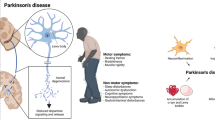Abstract
Parkinson’s disease (PD) is one of the most common neurodegenerative disorders. Despite the substantial progress that has been achieved, the precise mechanisms involved in the development of this disease are still not fully understood. The most common concepts relate to the genetic background and environmental/toxic effects. A number of model systems have been introduced, which mimic the human disease to varying extents. In this chapter, we introduce some of the most widely accepted protocols of the pharmacological models of Parkinson’s disease.
Access this chapter
Tax calculation will be finalised at checkout
Purchases are for personal use only
Similar content being viewed by others
References
Dorsey ER, Constantinescu R, Thompson JP, et al (2007) Projected number of people with Parkinson disease in the most populous nations, 2005 through 2030. Neurology 68:384–386.
O’Brien JA, Ward A, Michels SL, et al (2009) Economic burden associated with Parkinson disease. Drug Benefit Trend 21:179–190.
Henchcliffe C, Beal MF (2008) Mitochondrial biology and oxidative stress in Parkinson disease pathogenesis. Nat Clin Pract Neurol 4:600–609.
Klivenyi P, Starkov AA, Calingasan NY, et al (2004) Mice deficient in dihydrolipoamide dehydrogenase show increased vulnerability to MPTP, malonate and 3-nitropropionic acid neurotoxicity. J Neurochem 88:1352–1360.
Klivenyi P, Andreassen OA, Ferrante RJ, et al (2000) Mice deficient in cellular glutathione peroxidase show increased vulnerability to malonate, 3-nitropropionic acid, and 1-methyl-4-phenyl-1,2,5,6-tetrahydropyridine. J Neurosci 20:1–7.
Przedborski S, Levivier M, Jiang H, et al (1995) Dose dependent lesions of the dopaminergic nigrostriatal pathway induced by intrastriatal injection of 6-hydroxydopamine. Neuroscience 67:631–647.
Sauer H, Oertel WH (1994) Progressive degeneration of nigrostriatal dopamine neurons following intrastriatal terminal lesions with 6-hydroxydopamine: a combined retrograde tracing and immunocytochemical study in the rat. Neuroscience 59:401–415.
Jackson-Lewis V, Przedborski S (2007) Protocol for the MPTP model of Parkinson’s disease. Nat Protoc 2:141–151.
Jackson-Lewis V, Jakowec M, Burke RE, Przedborski S (1995) Time course and morphology of dopaminergic neuronal death caused by the neurotoxin 1-methyl-4-phenyl-1,2,3,6-tetrahydropyridine. Neurodegeneration 4:257–269.
Meredith GE, Totterdell S, Potashkin JA, Surmeier DJ (2008) Modeling PD pathogenesis in mice: advantages of a chronic MPTP protocol. Parkinsonism Relat Disord 14 Suppl 2:S112-115.
Fleming SM, Zhu C, Fernagut PO, Mehta A, et al (2004) Behavioral and immunohistochemical effects of chronic intravenous and subcutaneous infusions of varying doses of rotenone. Exp Neurol 187:418–429.
Peng J, Stevenson FF, Doctrow SR, Andersen JK (2005) Superoxide dismutase/catalase mimetics are neuroprotective against selective paraquat-mediated dopaminergic neuron death in the substantial nigra: implications for Parkinson disease. J Biol Chem 280:29194–29198.
Zhao F, Cai T, Liu M, et al (2009) Manganese induces dopaminergic neurodegeneration via microglial activation in a rat model of manganism. Toxicol Sci 107:156–164.
Ordoñez-Librado JL, Anaya-Martinez V, Gutierrez-Valdez AL, et al (2010) L-DOPA treatment reverses the motor alterations induced by manganese exposure as a Parkinson disease experimental model. Neurosci Lett 471:79–82
Castano A, Herrera AJ, Cano J, Machado A (1998) Lipopolysaccharide intranigral injection induces inflammatory reaction and damage in nigrostriatal dopaminergic system. J Neurochem 70:1584–1592.
Qin L, Wu X, Block ML, et al (2007) Systemic LPS causes chronic neuroinflammation and progressive neurodegeneration. Glia 55:453–462.
Ling Z, Gayle DA, Ma SY, et al (2002) In utero bacterial endotoxin exposure causes loss of tyrosine hydroxylase neurons in the postnatal rat midbrain. Mov Disord 17:116–124.
Klivenyi P, Ferrante RJ, Matthews RT, et al (1999) Neuroprotective effects of creatine in a transgenic animal model of amyotrophic lateral sclerosis. Nat Med. 5:347–350.
Zádori D, Geisz A, Vámos E, et al (2009) Valproate ameliorates the survival and the motor performance in a transgenic mouse model of Huntington’s disease. Pharmacol Biochem Behav 94:148–153.
Author information
Authors and Affiliations
Corresponding author
Editor information
Editors and Affiliations
Rights and permissions
Copyright information
© 2011 Springer Science+Business Media, LLC
About this protocol
Cite this protocol
Klivenyi, P., Vecsei, L. (2011). Pharmacological Models of Parkinson’s Disease in Rodents. In: Manfredi, G., Kawamata, H. (eds) Neurodegeneration. Methods in Molecular Biology, vol 793. Humana Press, Totowa, NJ. https://doi.org/10.1007/978-1-61779-328-8_14
Download citation
DOI: https://doi.org/10.1007/978-1-61779-328-8_14
Published:
Publisher Name: Humana Press, Totowa, NJ
Print ISBN: 978-1-61779-327-1
Online ISBN: 978-1-61779-328-8
eBook Packages: Springer Protocols




